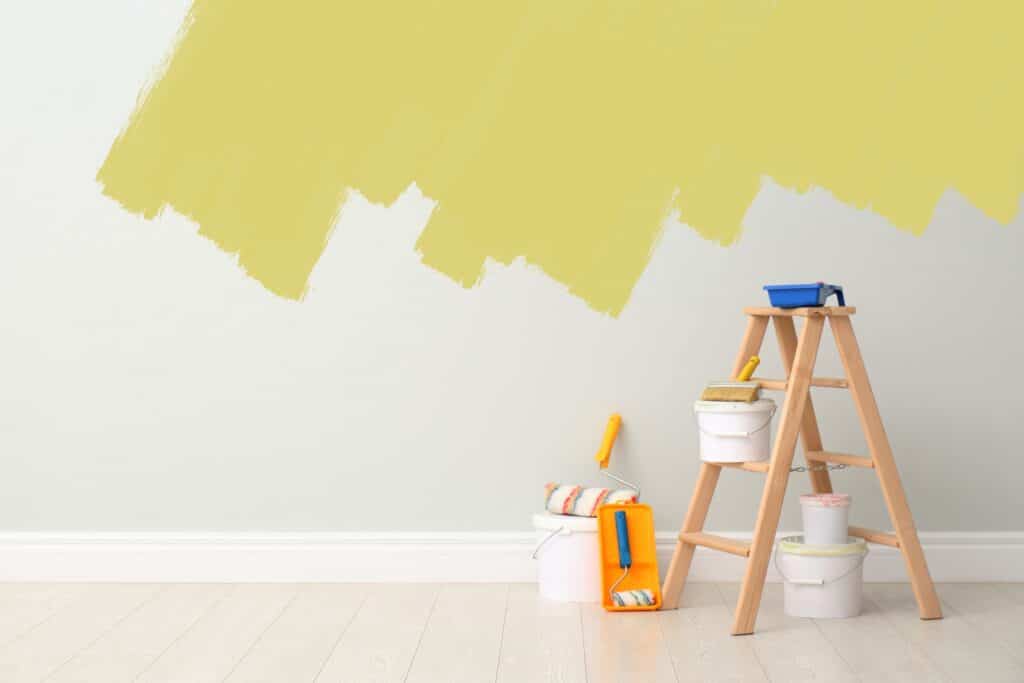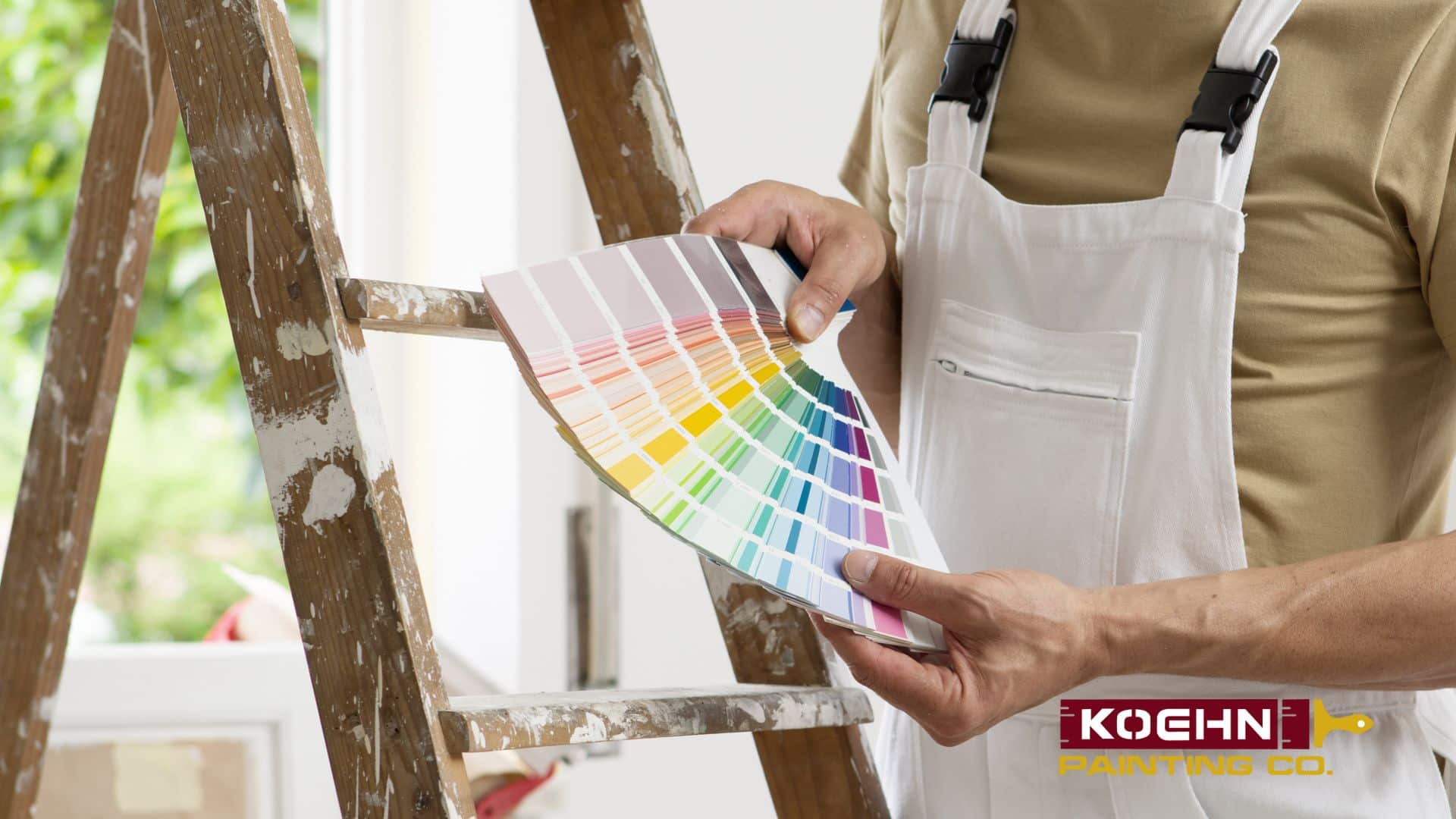Table of Contents
ToggleIs this person the expert they claim to be? Will they deliver quality work or leave you with a poor result? Can you trust them to stick to their promises and timeline? When hiring a house painter, these are the questions that might be running through your mind.
We’ve compiled a list of 20 important questions to ask your house painter before hiring them. Take a look before scrolling down.
10 Questions To Ask Your Exterior House Painter

Every decade or so, your house outdoors needs a new coat of paint to keep it looking good and protected from the elements. Painting the exterior yourself can take a lot of time and effort, especially if the house has multiple floors. That’s why many people decide to hire an exterior house painter.
You need to do some research, find someone affordable, and set up interviews. Remember to ask the house painter these questions when discussing your project.
1. How do you prepare exterior surfaces before painting, especially for older homes in Wichita?
These are the six fundamental steps a good house painter should follow:
- Clean in-depth: Remove any dirt, mildew, or buildup on the surface using a power washer or scrub brush. Wichita’s climate can lead to a lot of grime, so a painter needs to start with a clean surface.
- Repair damage: Fix any cracks, holes, or damaged areas using fillers or patching compounds. For older homes, it’s important to check for any wood rot or structural issues.
- Scrape and sand: Remove any loose or peeling paint, then sand the surface smooth. This will allow the new paint to adhere properly.
- Prime the surface: Apply a high-quality primer to seal the surface and create a good base for the paint.
- Caulk gaps: Seal any gaps around windows, doors, and trim to keep moisture out and protect the paint job.
- Protect and mask: Cover any areas that shouldn’t be painted, like windows and landscaping, with masking tape and protective coverings.
2. What type of primer do you use for exterior surfaces, and why?
The painter could offer you different options.
- Acrylic primer is an excellent all-purpose option. This water-based primer works well for most wood coatings and finishes, galvanized metal, and some siding materials such as T-111 and Hardie board. Acrylic primers are easy to clean and provide excellent adhesion and flexibility.
- Alkyd primer is a less popular oil-based alternative but still useful for some jobs. For example, it helps prevent rust when painting steel and wrought iron. Also, if you plan to use an oil-based finish, the alkyd primer will make it adhere better.
- For brick, concrete, stucco, and other masonry surfaces, the painter should use a Primer Formulated for Masonry, which is more breathable and allows moisture to escape without damaging the paint.
Specialty primers address specific problems. If exterior surfaces may have mold, choose an anti-mold primer. For areas exposed to constant sunlight, a primer that blocks UV rays will prevent fading.
3. How do you handle painting hard-to-reach areas like eaves and high peaks?
- Extendable ladders: These ladders are quick to assemble and offer flexibility for different heights and angles. For uneven terrain, a tripod ladder with stabilizing legs is best.
- Scaffolding towers: For larger projects, a scaffold on wheels offers a stable and adjustable platform. Unlike traditional scaffolding, scaffolding towers are easier to move and assemble.
- Extension poles: They can extend up to 16 feet and attach to rollers or brushes.
- Access platforms: Useful for low-level work, they provide a safe and stable surface and can be used with extension poles to reach higher areas.
4. What measures do you take to protect my landscape and outdoor furniture during the painting process?
First, heavy tarps should be spread over plants, shrubs and furniture to protect them from paint splashes. Instead, for larger items and delicate plants, it is best to use plastic sheeting for added protection.
Professional painters also think about moving portable furniture and decorations and applying painter’s tape to edges and trim. Finally, the work area is kept clean, and debris and paint chips are removed to prevent them from settling on the landscape or furniture.
5. How do you ensure the paint will withstand the specific weather conditions in Wichita?
Don’t feel challenged by Wichita’s unstable weather. A professional painter knows how to deal with it. We have also written a guide about this, and you can find it here.
Remember, painters should start by choosing a high-quality, weather-resistant paint that can resist the city’s temperature extremes and humidity. Aim to schedule your painting project for late spring or early autumn when the temperatures are milder, and the humidity is just right.
6. Can you recommend the best type of paint for exterior use in our climate?
Experienced exterior painters know their paints and their brands. We at Koehn Painting often suggest using credible brands such as Sherwin-Williams. They are high-quality and dependable. If any problems come up, Sherwin Williams stands behind their products, so your project is covered.
7. How do you deal with mildew or mold on the exterior surfaces before painting?
- Identify the problem: Mold occurs as black, gray or brown spots, often in damp, shady areas such as under eaves or near overgrown shrubs.
- Removing mold: Before painting, good painters must remove all mold. They usually use a mixture of 1 part household bleach and 3 parts water. Scrub the affected areas well, then rinse with a garden hose. For larger areas, the best option is power washing.
- Apply a primer to the surface: Once the mold has been removed and the surface has dried, the next step will be to apply a primer.
- Use mold-resistant paint: To finish, painters should choose a quality exterior paint designed to resist mold growth in the future.
8. What is your process for removing old paint or preparing previously painted surfaces?
Be sure to hear that all these tasks will be performed:
- Inspect the surface: Check for brittle, flaky paint, bubbles, or damage that needs repair.
- Gather tools: Workers will need a paint scraper, putty knife, sandpaper (80-120 grit), paint stripper, heat gun, and protective gear (gloves, safety goggles, respirator mask).
- Remove old paint: First, use a sanding block or power sander to remove old paint and smooth the surface. Then, use a paint scraper or putty knife to scrape off loose paint.
- Clean the surface: Wash the area with water and detergent, especially if it is adhesive paint. Apply the solution with a brush or roller, then scrape off the softened layer.
- Repair and apply primer: Fill any cracks or holes with putty, then sand. Apply a suitable primer, especially if changing paint types or covering up stains.
- Final preparation: Clean the wall with a damp cloth to remove dust and ensure a clean surface for painting.
9. How long should I expect the exterior paint job to last before needing a repaint?
When you should repaint the outside of your home depends on a few factors. Generally, you’ll need to do it every 5 to 10 years. But the exact timeline can vary based on how well the previous paint job held up, the quality of the paint you used, the weather conditions where you live, and the material you’re painting (like wood, siding, or brick).
10. How do you handle any potential lead paint issues on older homes?
First, painters should check if the paint contains lead by using a lead test kit or contacting a professional. If lead is present, they must wear protective clothing such as gloves, masks, and goggles. They should also cover the work area with plastic sheeting to collect dust or paint chips. Close doors and windows to prevent lead dust from spreading and over the ground and surrounding areas with plastic sheeting.
The lead can be removed using methods such as wet sanding or a heat gun set at less than 1,100°F to avoid lead fumes. Avoid dry sanding or scraping, which can release harmful dust.
After removing the paint, painters must clean the area with a HEPA vacuum, wipe surfaces with a damp cloth, and dispose of all contaminated materials. As a last step, they will apply a primer and sealer to block any remaining lead particles, then finish with a high-quality exterior paint.
Good exterior painters will happily answer all these questions to make sure you get the best results. Contact us today to find the right contractor for your exterior or commercial painting needs!
10 More Questions To Ask Your Interior House Painter

An interior house painter should be happy to answer your questions and guide you through the process. Especially if you live in an older property in Wichita, it’s important to find a house painter who is experienced and understands the challenges of older homes.
Wichita house painters know these ins and outs and can provide the expertise you need. Before you start your next interior painting project, here are 10 essential questions to ask.
1. How do you prepare interior surfaces before painting, especially for older homes in Wichita?
Preparing interior surfaces before painting, especially in older homes, involves several steps for interior painters:
- Correct imperfections: Start by scraping off cracked or peeling paint and smooth sharp edges to create an even surface.
- Fill holes and cracks: Use a quick-drying putty compound to fill any holes or cracks. Once dry, sand the areas until level.
- Seal cracks: Apply caulk around windows, siding and other gaps and smooth it out with a damp finger to achieve a flush finish.
- Clean surfaces: Clean ceilings, walls and trim to remove dirt, cobwebs or anything else. You can use a duster or a broom covered with an old pillowcase to do this.
- Wash the walls: Wash the walls with a mild cleaning solution to remove any remaining dirt and lightly roughen the surface to make the paint stick better.
2. What type of paint do you recommend for high-traffic areas like hallways and kitchens?
For high-traffic areas, painters must choose a durable, easy-to-clean paint. Duration Home Interior Acrylic Latex by Sherwin Williams and Benjamin Moore Ultra Spec SCUFF-X are excellent options. They offer premium coverage, advanced stain blocking, and are resistant to scuffs and mildew.
Warm tones like tans, browns, shades of gray, and earth tones are practical for these areas, as they help mask imperfections. Eggshell or high-quality matte finishes are perfect, as they are smooth and stain-resistant, making maintenance easy.
3. Do you offer any eco-friendly or low-VOC paint options for interior painting?
Eco-friendly and low-VOC paint options create a healthier environment for your home. Great choices include brands like Sherwin Williams, ECOS Paints, and Benjamin Moore. ECOS Paints offer zero-VOC, non-toxic options that are perfect for improving indoor air quality.
Similarly, Benjamin Moore’s Eco Spec line provides zero-VOC paints that are Green Seal certified, emitting fewer harmful chemicals. These paints are ideal for any interior space, including nurseries and bedrooms. Ask your interior painter about their options and see if they use any of these top brands.
4. How do you protect my furniture, flooring, and fixtures during the interior painting process?
- Plastic sheeting and drapes: Plastic sheeting is used to cover floors and furniture, protecting them from splashes and drips of paint. Plastic sheeting provides an additional moisture barrier, especially for carpets.
- Painter’s tape: This is applied to edges and trim to create clean lines and prevent paint from spilling onto adjacent surfaces.
- Furniture covers: Blankets or protective covers are spread over furniture secured with tape or straps to prevent movement and accidental exposure to paint.
5. What is your process for dealing with wall imperfections like cracks and holes before painting?
First, the area is cleaned to get rid of dust and debris, which helps the filler stick better. Then, spackling or joint compound is applied with a putty knife, adding it in layers for deeper cracks.
Once it’s dry, the surface is lightly sanded to ensure smoothness, and any dust is wiped away with a damp cloth. A good primer, like Benjamin Moore Fresh Start, is then used to seal the area and prevent the filler from soaking up the paint.
For nail pops, the nail is pushed back in, secured with screws, and the holes are filled like any other small imperfection. Remember all these steps when hiring an exterior house painter.
6. Can you assist with selecting the right finishes (e.g., matte, eggshell, satin) for different rooms?
A good team of painters can definitely help you choose the right finishes for each room in your home. Different finishes serve different purposes and suit different spaces.
7. How do you handle painting detailed areas like trim, molding, and built-in cabinetry?
- Taping and protection: Professional painters use high-quality painter’s tape to mask off areas that shouldn’t be painted, like walls, floors, and hardware. The tape is pressed down firmly to prevent the paint from bleeding. The floors and nearby furniture are covered with drop cloths and plastic sheeting.
- Painting: Interior painters use fine, angled sash brushes for detailed work on trim and molding. On larger, flat areas of cabinetry, they might use foam rollers or an HVLP sprayer. The paint is applied in thin, even layers. For high-touch areas like cabinetry, it’s recommended to use a durable enamel paint, such as acrylic latex or oil-based enamel, which provides a hard, long-lasting finish. Typically, two to three coats are applied, with light sanding between each coat.
8. How long will it take for the interior paint to dry, and when can rooms be used again?
The drying time for interior paint can vary based on the type of paint and environmental conditions. Generally, paint can be dry to the touch within an hour, but it usually takes about 24 hours before it’s ready for a second coat. However, for the paint to fully cure and withstand washing or heavy use, it may take up to two weeks.
The drying time of interior paint can vary depending on the type of paint and the surrounding conditions. Typically, paint is dry to the touch within an hour, but it usually takes about 24 hours before it is ready for a second coat. However, it can take up to two weeks for the paint to fully cure and be able to withstand washing or heavy use.
9. Do you offer any advice on maintaining the interior paint job to extend its lifespan?
An interior painter worth the price would tell you this:
- Clean walls regularly with a soft cloth and mild soap to keep them looking fresh.
- Clean stains right away to prevent them from forming.
- Use exhaust fans in damp rooms such as the bathroom and kitchen to reduce moisture that can cause peeling or mold.
- Save leftover paint for touch-ups on small nicks and scratches.
- Protect walls by using furniture mats and mats at the entrance to reduce dirt from seeping in.
- Check the walls occasionally for damage and repair it right away.
10. How do you handle painting ceilings and ensuring a clean finish without drips?
As with exterior painting services, begin by applying a primer to prepare the surface. Use a roller with an extension rod to achieve even coverage, rolling consistently to avoid overlaps. To avoid drips, load the roller lightly and use a paint guard along the edges.
Trimming the edges with a brush before rolling helps achieve clean lines. Finally, apply several thin coats rather than one thick coat, letting each one dry properly.
Why You Should Choose Koehn as Your Exterior or Interior House Painter

If you are searching for interior and exterior painting services in Wichita, KS, Koehn Painting is the house painter of choice. We back our work with a 100% Satisfaction Guarantee and a 1-year Iron Warranty. If there are any problems with our work or painting, we will come back and repair them at no extra charge.
We are fully licensed and insured, so you are protected every step of the way. Our estimates are firm, with no hidden costs or surprises. We use high-quality Sherwin Williams paints, known for their durability and excellent finish. We also respect your home by keeping your work area clean and tidy every day, until the project is done.
At Koehn Painting, your satisfaction is our priority. We do not accept payment until you are completely satisfied with the results.
Choose Koehn Painting for a professional, stress-free painting experience. Contact us today to get started!





